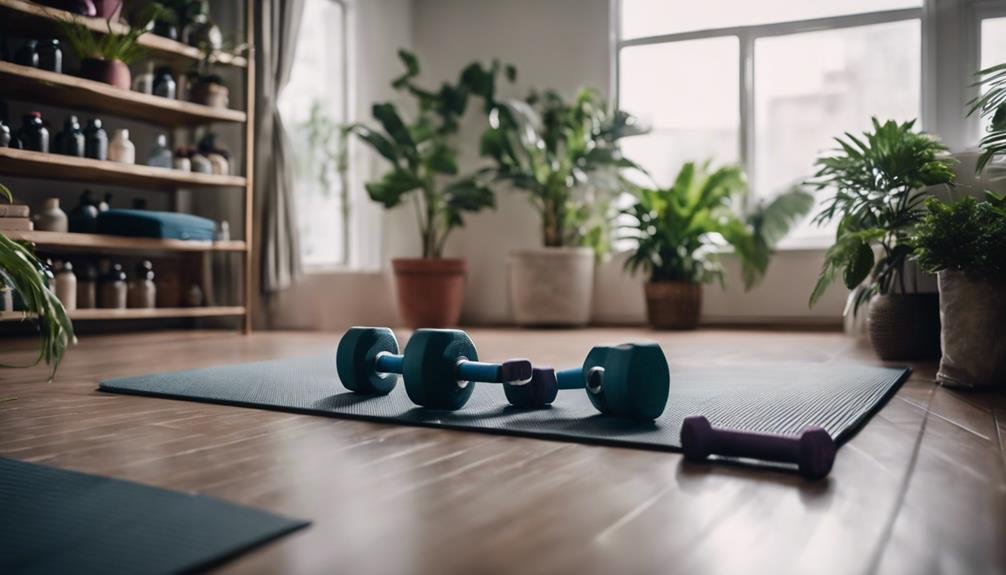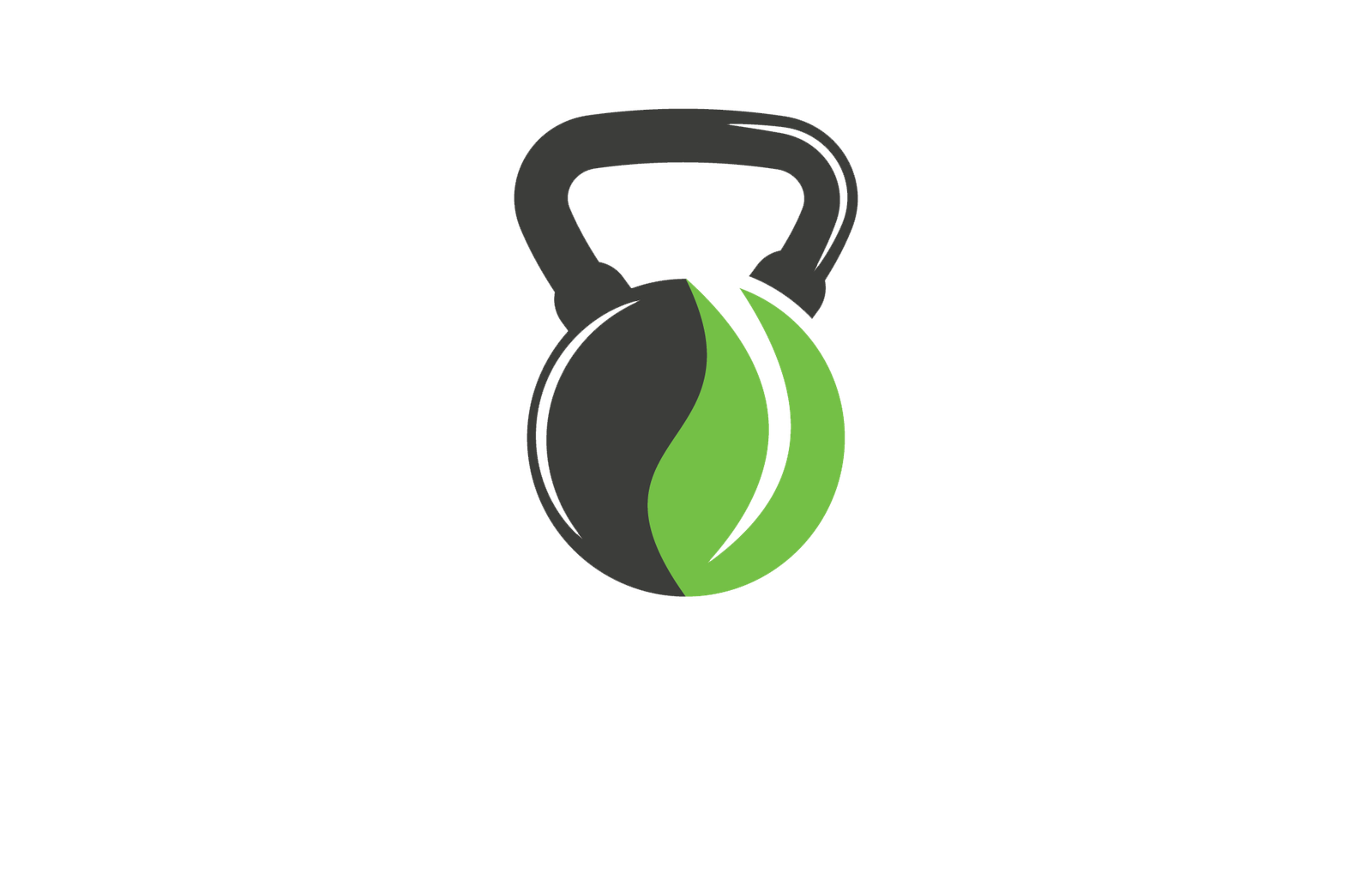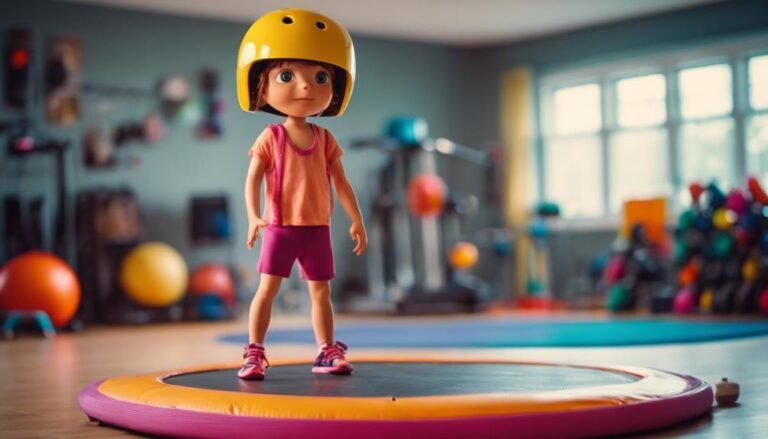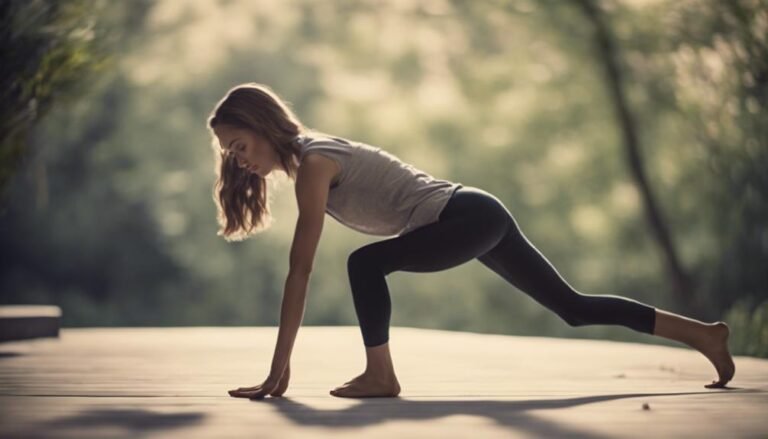Don't miss our holiday offer - 20% OFF!

Managing Allergies in a Home Gym Environment
Transform your home gym into an allergy-free haven with these essential tips to breathe easy and exercise freely.
We recognize the importance of managing allergies in our home gym environment. Identifying common allergens like dust, dander, and pollen is essential to minimizing exposure. Effective measures include using air purifiers, fabric shields on equipment, and regular cleaning and disinfecting routines. Proper ventilation, humidity control, and mold prevention also play a key role. We can take it a step further by implementing pet-free zones, mat cleaning schedules, and sealing entry points to prevent outdoor allergens from entering our workout space. By taking these proactive steps, we can create a safe and healthy environment to exercise and improve our overall well-being, and there's more to explore to make our home gym a haven for our health.
Key Takeaways
- Identify and manage allergens by recognizing triggers, controlling dust and dander, and implementing cleaning and disinfecting routines.
- Ensure proper ventilation and air purification systems to remove allergens, irritants, and pollutants from the air.
- Implement humidity control measures to prevent mold growth, which can exacerbate allergies and respiratory issues.
- Designate pet-free zones and take precautions to minimize pet dander and allergens in the home gym environment.
- Develop regular cleaning and disinfecting schedules, including daily, weekly, and monthly routines to maintain a hypoallergenic workout space.
Identifying Common Allergy Triggers
We come into contact with countless substances every day, and for some of us, these encounters can trigger an allergic reaction. As we go about our daily lives, we're exposed to a multitude of potential allergens, from the food we eat to the air we breathe. Food sensitivities, in particular, can be a significant concern, as even small amounts of certain ingredients can cause a reaction. For those who experience seasonal allergies, the changing of the seasons can bring new challenges. Seasonal fluctuations in pollen counts, for instance, can wreak havoc on our sinuses and respiratory systems. We must be aware of these common allergy triggers to take steps to manage our environments and minimize our exposure. By recognizing the substances that can trigger allergic reactions, we can take proactive measures to create a safer, healthier space for ourselves and those around us.
Dust and Dander Control Measures
Effective dust and dander control measures begin with a thorough understanding of the environments where allergens accumulate, and a willingness to adapt our cleaning habits to mitigate their impact. We've learned that dust and dander are two of the most common allergens found in home gyms, and that they can exacerbate respiratory issues like asthma. To combat this, we recommend investing in air purifiers that can capture 99.97% of particles as small as 0.3 microns, including dust, dander, and other airborne allergens. Additionally, using fabric shields on our gym equipment can help reduce the accumulation of dust and dander on surfaces. We've found that these shields are especially effective on upholstered equipment like exercise bikes and elliptical machines. By implementing these measures, we can substantially reduce the amount of allergens present in our home gym environment, creating a safer and healthier space for everyone to exercise.
Cleaning and Disinfecting Equipment
By incorporating a regular cleaning and disinfecting routine into our gym maintenance, we can substantially reduce the presence of germs, bacteria, and viruses on our equipment. This is vital in preventing the spread of illnesses and allergic reactions. We prioritize gym sanitation by allocating time each week to thoroughly clean and disinfect our equipment. This includes wiping down machines, free weights, and mats with a gentle yet effective disinfectant. We pay special attention to high-touch areas such as handlebars, grips, and seats. Equipment sterilization is also key, as it confirms that our equipment is not only clean but also free of germs and bacteria. We use a combination of cleaning products and UV light technology to achieve superior results. By maintaining a clean and sanitized environment, we can minimize the risk of allergic reactions and guarantee a healthier workout experience for everyone. Regular cleaning and disinfecting also helps extend the lifespan of our equipment, saving us money in the long run.
Ventilation and Air Purification
Proper ventilation and air purification systems are essential in our gym, as they help remove allergens, irritants, and pollutants from the air, substantially reducing the risk of allergic reactions and respiratory issues. We recognize that poor air quality can exacerbate allergies and asthma, making it vital to prioritize ventilation and air purification. To achieve ideal air quality, we install high-quality air purifiers that capture 99.97% of particles as small as 0.3 microns, including dust, pollen, and pet dander. We also verify that our air purifiers have fresh filters, which we replace regularly to maintain their effectiveness. By doing so, we can notably reduce airborne allergens and irritants, creating a healthier environment for our gym-goers. Additionally, we make sure that our ventilation system is designed to exchange stale air for fresh air, providing a constant supply of clean air throughout the gym. By prioritizing ventilation and air purification, we can create a safe and healthy environment for everyone to work out and achieve their fitness goals.
Humidity Control and Mold Prevention
As we work to manage our allergies, we recognize the importance of controlling humidity levels in our living spaces. We've learned that excessive moisture can lead to mold growth, which can exacerbate our allergies and respiratory issues. Now, let's explore how to maintain ideal humidity levels and prevent mold growth in our homes.
Humid Air Quality
We often find ourselves struggling to breathe easily in humid environments, where moisture-laden air can exacerbate our allergy symptoms and create an ideal breeding ground for mold growth. As home gym enthusiasts, it's vital to maintain a comfortable and healthy environment. One way to achieve this is by controlling the air moisture levels.
| Humidity Level | Air Quality | Dehumidifier Benefits |
|---|---|---|
| 50-60% | Comfortable | Reduces allergy symptoms |
| 60-70% | Mildly humid | Inhibits mold growth |
| 70-80% | Humid | Removes excess moisture |
| 80-90% | Very humid | Relieves congestion |
| Above 90% | Extremely humid | Essential for air quality |
Mold Growth Prevention
By regulating humidity levels, we can effectively prevent mold growth and create a healthier environment for our workout routines. Mold thrives in humid conditions, and controlling moisture is vital to preventing its growth. We can achieve this by maintaining a consistent humidity level between 30-50%.
To ensure our home gym remains mold-free, we should:
- Conduct regular dehumidifier maintenance: Clean the dehumidifier's filter, and check for any blockages or leaks to guarantee it's working efficiently.
- Implement moisture mapping: Identify areas prone to moisture accumulation, such as corners and crevices, and take measures to improve air circulation around these areas.
- Monitor humidity levels regularly: Use a hygrometer to track humidity levels and adjust our dehumidifier accordingly to maintain the ideal range.
Pet-Friendly Home Gym Precautions
When setting up a pet-friendly home gym, we must take specific precautions to guarantee our workout space remains safe and allergen-free for both humans and pets. As pet owners, it's common knowledge that pet allergies are a frequent issue, and pet dander is a primary culprit. To minimize the risk of allergic reactions, we recommend designating a pet-free zone within our home gym. This can be achieved by setting up a pet-free area where we can exercise without exposing ourselves to pet dander. Additionally, we should vacuum and dust regularly to remove any pet dander that may have accumulated. It's also essential to wash our hands thoroughly after interacting with our pets before engaging in physical activity. By taking these precautions, we can certify a safe and enjoyable workout experience for everyone, including our furry friends. By being mindful of pet allergies and taking proactive steps, we can create a harmonious and healthy environment for both humans and pets.
Pollen and Outdoor Allergen Entry
As we work to manage our allergies, we need to focus on preventing pollen and outdoor allergens from entering our homes. We'll explore ways to keep these unwanted visitors out, from installing screened vents and filters to establishing regular mat cleaning schedules and sealing entry points. By taking these steps, we can reduce our exposure to outdoor allergens and breathe easier.
Screened Vents and Filters
We often overlook the importance of screened vents and filters in keeping outdoor allergens, like pollen, out of our living spaces. However, these components play a vital role in maintaining a healthy indoor environment, especially in our home gyms. By installing screened vents and regularly maintaining our air filters, we can greatly reduce the amount of pollen and other outdoor allergens that enter our homes.
- Regularly inspect and clean our air vents to prevent dust and debris accumulation, which can exacerbate allergies.
- Replace air filters every 1-3 months, depending on usage and manufacturer's instructions, to maximize performance.
- Upgrade to HEPA filters, which can capture 99.97% of particles as small as 0.3 microns, including pollen, dust, and other allergens.
Mat Cleaning Schedules
Every day, we track in pollen and outdoor allergens on our shoes, clothes, and gear, making regular mat cleaning schedules essential for preventing the spread of allergens in our home gyms. To maintain a clean and allergy-friendly environment, we've developed a mat maintenance routine that's easy to follow.
| Frequency | Cleaning Method |
|---|---|
| Daily | Quick wipe-down with a damp cloth |
| Weekly | Deep clean with a mild detergent and warm water |
| Monthly | Sanitize with a disinfectant spray |
Sealing Entry Points
By sealing the gaps and cracks around doors, windows, and vents, we can effectively prevent pollen and outdoor allergens from entering our homes. This is a crucial step in managing allergies in our home gym environment. When we neglect to seal these entry points, we inadvertently invite allergens to infiltrate our space, exacerbating our allergy symptoms.
To ensure a thorough seal, we should:
- Inspect and replace worn-out weatherstripping, as it can lead to weatherstripping mistakes that compromise our efforts.
- Explore caulk alternatives, such as spray foam or silicone sealants, to find the most effective solution for our specific needs.
- Check for hidden gaps, such as those around electrical outlets and switches, to ensure a comprehensive seal.
Creating a Hypoallergenic Workout Space
To guarantee a comfortable and safe workout experience, our gym or exercise space should be designed to minimize allergens and irritants. We can achieve this by selecting gym decor that promotes workout wellness. For instance, we can opt for flooring made from natural materials like wood or bamboo, which are less likely to harbor allergens compared to carpets. Additionally, we can choose workout equipment with smooth, easy-to-clean surfaces to reduce the accumulation of dust and allergens. It's also essential think about the type of lighting we use. We should opt for lighting options that don't produce harsh chemicals or ozone, which can exacerbate respiratory issues. In addition, we can incorporate plants that are known to purify the air, such as spider plants or peace lilies, to create a healthier workout environment. By making these conscious design choices, we can create a hypoallergenic workout space that supports our overall well-being and allows us to focus on our fitness goals.
Regular Deep Cleaning Schedules
As we work to manage our allergies, maintaining a clean environment is essential. That's why we're going to establish regular deep cleaning schedules to reduce our exposure to allergens. By incorporating daily sanitizing routines and weekly disinfecting schedules into our cleaning regimens, we'll create a safer, healthier space for ourselves.
Daily Sanitizing Routines
We establish daily sanitizing routines to minimize exposure to allergens and reduce the risk of allergic reactions in our homes. As home gym enthusiasts, we understand the importance of a clean environment to ensure our health and well-being.
To maintain a clean and hygienic space, we incorporate the following daily sanitizing routines into our schedules:
- Wipe down equipment: We use gym wipes to quickly sanitize our equipment after each use, paying special attention to high-touch areas like handles and grips.
- Clean high-traffic areas: We sweep and mop our floors daily to remove dirt, dust, and other allergens that can aggravate respiratory issues.
- Disinfect high-touch surfaces: We sanitize surfaces like doorknobs, light switches, and countertops to prevent the spread of germs and allergens.
Weekly Disinfecting Schedules
In addition to our daily sanitizing routines, we prioritize weekly disinfecting schedules to tackle deeper cleaning tasks that require more attention and elbow grease. This maintains our home gym environment as a safe haven for allergy sufferers. We allocate specific days for tasks like scrubbing equipment, vacuuming, and mopping to maintain a high level of cleanliness. By doing so, we can effectively minimize the accumulation of allergens and germs that can exacerbate allergy symptoms.
Our weekly disinfecting schedules are designed to be flexible, allowing us to adjust tasks according to our gym's unique needs. For instance, if we've had a particularly busy week, we might dedicate extra time to sanitizing high-touch areas or deep cleaning equipment with high allergen potential. By incorporating schedule flexibility, we can guarantee our gym sanitize efforts remain effective and efficient. By staying on top of our weekly disinfecting schedules, we can confidently provide a clean and healthy environment for our members to work out and thrive.
Disinfecting High-Touch Areas
By regularly disinfecting high-touch areas, we reduce the risk of allergen exposure and prevent the spread of germs that can exacerbate allergic reactions. In a home gym environment, we must prioritize gym sanitation and surface hygiene to create a safe space for everyone.
To maintain a clean and healthy environment, we focus on disinfecting the following high-touch areas:
- Equipment handles and grips: From dumbbells to treadmill handles, these areas are prone to harboring germs and allergens.
- Door handles and light switches: Frequently touched surfaces that can spread germs and allergens throughout the gym.
- Mat surfaces and floors: Regular disinfection of these areas prevents the buildup of germs and allergens that can exacerbate allergic reactions.
Managing Fabric and Upholstery Allergens
Fabric and upholstery in the gym, from exercise mats to workout benches, can harbor allergens like dust mites, mold, and pet dander, which can exacerbate respiratory issues and other allergic reactions. It is essential that regular cleaning and disinfecting are undertaken, but what about the fabric itself? It has become clear that fabric testing is vital to identify potential allergens. By testing the fabric, we can determine the type of material, its weave, and any treatments it may have undergone. This information helps us choose the right cleaning products and methods to minimize allergen exposure. We've also consulted with upholsterers who specialize in gym equipment, and their insights have been invaluable. Through these interviews, we've gained a better understanding of how upholstery is constructed and how to properly maintain it to reduce allergen buildup. By combining fabric testing and upholsterer expertise, we can create a thorough plan to manage fabric and upholstery allergens in our home gym.
Reducing Exposure to Chemical Irritants
As we work out in our home gym, we're not only breathing in dust and allergens, but also chemical irritants that can aggravate our respiratory system and skin. These chemical irritants can come from various sources, including cleaning products, paints, and even some exercise equipment. To reduce our exposure to these chemical irritants, we need to take proactive steps.
- Opt for fragrance-free products: When shopping for cleaning products, personal care items, and exercise equipment, choose fragrance-free options to minimize our exposure to harsh chemicals.
- Use latex alternatives: If we have a latex allergy or sensitivity, we should opt for latex-free or hypoallergenic alternatives for exercise equipment, such as yoga mats and resistance bands.
- Ventilate our home gym: Proper ventilation is key to reducing our exposure to chemical irritants. We should facilitate good airflow in our home gym by opening windows, using fans, or installing a ventilation system.
Personal Protection and Emergency Prep
Wearing protective gear and having a plan in place can greatly reduce our risk of an allergic reaction or injury while working out in our home gym. As we exercise, we can take steps to protect ourselves from potential allergens and be prepared in case of an emergency.
To safeguard our safety, we should always wear protective gear such as gloves, masks, and goggles when using equipment or cleaning chemicals. We should also have an emergency kit on hand, stocked with essentials like antihistamines, epinephrine injectors, and a first aid guide.
Here's a checklist to help us prepare:
| Item | Description | Location |
|---|---|---|
| Antihistamines | For mild allergic reactions | Gym bag |
| Epinephrine injector | For severe allergic reactions | Gym bag |
| First aid guide | For emergency procedures | Gym wall |
Frequently Asked Questions
What Are Some Allergy-Friendly Alternatives to Latex Exercise Equipment?
We opt for allergy-friendly alternatives to latex exercise equipment, choosing natural rubber or eco-friendly materials, silicone options, and hypoallergenic coatings that provide a safe and healthy workout environment for everyone.
Can I Use Air Purifiers With HEPA Filters in a Home Gym?
'Can't we all breathe a little easier with cleaner air? We can definitely use air purifiers with HEPA filters to improve indoor air quality, but we must prioritize regular filter maintenance for peak performance.'
How Often Should I Replace My Home Gym's HVAC Air Filters?
We typically replace our HVAC air filters every 1-3 months, depending on usage, to maintain peak Filter Maintenance and improve Air Quality; this schedule helps prevent dust and debris buildup, promoting a healthier breathing environment by guaranteeing a pristine air flow.
Are There Any Allergy-Friendly Flooring Options for a Home Gym?
We opt for eco-friendly flooring options, like rubber flooring, which is hypoallergenic, easy to clean, and resistant to mold and mildew, making it an ideal choice for our home gym.
Can I Use Essential Oils to Naturally Freshen My Home Gym Air?
We breathe a sigh of relief, symbolizing a fresh start, as we explore using essential oils to naturally freshen our air. We opt for gentle Oil Blends, catering to individual Scent Preferences, ensuring a harmonious atmosphere, free from harsh chemicals.
Conclusion
As we wrap up our home gym's allergy-fighting playbook, we're reminded that a healthy sweat session shouldn't come at the cost of our well-being. By tackling dust, dander, and other common allergy triggers, we create a safe haven for our bodies to thrive. With a few simple tweaks to our cleaning routine, ventilation, and personal habits, we can breathe easy – literally – and focus on what matters most: crushing our fitness goals.



